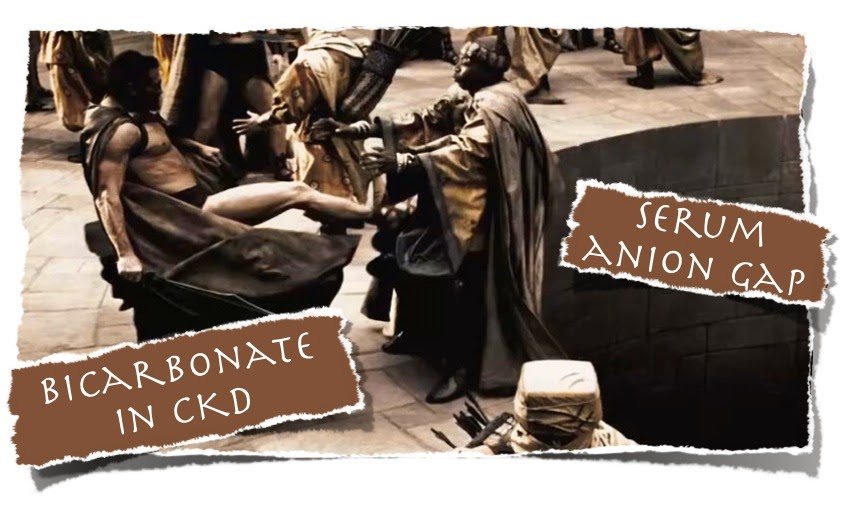Serum anion gap - out. MUD PILES. if god forbid anyone actually diagnose anything that causes ARF. #Employment #NephMadness
— Michael Katz (@MGKatz036) March 31, 2014
The serum anion gap was an entry on the electrolyte region of NephMadness. It won it's opening round over urine anion gap and advanced to the Sweet 16 by beating hypertonic saline but failed to win the electrolyte region when it fell to Bicarbonate in CKD.CJASN did a recent review of the anion gap and they were frank with its limitations:
Some interesting notes about the anion gap: though the serum potassium was included in the original derivation of the calculation, none of the major U.S. textbooks include it. The upper limit of normal anion gap from the 8 sources included in the paper is much higher than I teach. I use 12 and after the ASN Board Review Class, I remember feeling that was too high.
The article then discusses the fact that ion selective electrodes are more sensitive for chloride so they detect higher chloride concentrations so that average and pathologic anion gaps are lower.
The article discusses the importance of albumin in the normal anion gap. As albumin falls, either the limit for a pathologically elevated anion gap needs to fall or the calculated anion gap needs to be adjusted upwards. The article recommends the latter. The anion gap should rise 2.5 for ever 1 g/dL the albumin falls below normal (presumably 4 g/dL). The authors recommend that albumin adjustments be incorporated into laboratory reporting so clinicians do not need to worry about this.
@kidney_boy Ah yes, correcting the gap for low albumin. #ubergeek
— rob rogers (@EM_Educator) April 1, 2014
@EM_Educator the way to turn the anion gap from an abysmal test for lactic acidosis to merely a bad test for lactic acidosis
— Joel Topf (@kidney_boy) April 1, 2014
The meat of the article is contained in table 3 where the authors review 5 studies that looked at the sensitivity of an increased anion gap for lactic acidosis. It's not a pretty picture.
The anion gap is meant to be a screening test, if it is positive the specific cause of the increased anion gap can be investigated with specific assays. Screening tests are supposed to be sensitive so that if they are negative one can rule out that potential diagnosis. Here we see that the anion gap is wearing no clothes. Sensitivity can be as bad as 43%, but typically runs around 60-70%.
In Adams et. al's (PDF) analysis of emergency department patients, 50% of patents with a lactate level between 5 and 9.9 had an anion gap below 12!
The authors theorize that the anion gap fails due to the broad range of normal in the anion gap. The normal anion gap can range from 3 to 12, so suppose a patient is sitting at the low range of normal say 3 or 4, they could absorb an lactate level up to 8 or 9 mmol/L while still maintaining a normal anion gap. See the illustrations with Gamblegrams below:
 |
| Both James and Jean Luc start with normal anion gaps, though James is at the upper limit and Jean Luc is at the lower limit of normal. |
 |
| Both patients develop equivalent and significant lactic acidosis but only James develops an anion gap |
The article then describes some unusual behaviors of the anion gap. The first is that the anion gap can rise more than the bicarbonate falls. A basic tenet of the anion gap is that the ratio of the change of bicarb and the anion gap is 1:1, this is the theory that the delta gap equation rests on. In lactic acidosis apparently the the anion gap can rise 1.8 for every fall in the bicarbonate of one. The net result of this is patients can have significant lactic acidosis in the presence of a normal serum bicarbonate.
Additionally, patients with identified organic acidosis, the identified acid typically does not explain the entire gap.
The authors discuss some data on using personalized normal anion gap targets from previous labs. This would help the sensitivity of the test in patients who run low normal anion gaps and have a hard time cross the threshold for an increased anion gap (see Jean Luc above). However, the authors point to a study (Lipnick et al. 2013) which used this technique and still missed approximately 30% of lactic acidosis cases.
This is a good article but it does not address issues such as the the anion gap's usefulness in the diagnosis of the toxic alcohols and its use in the management of DKA.





